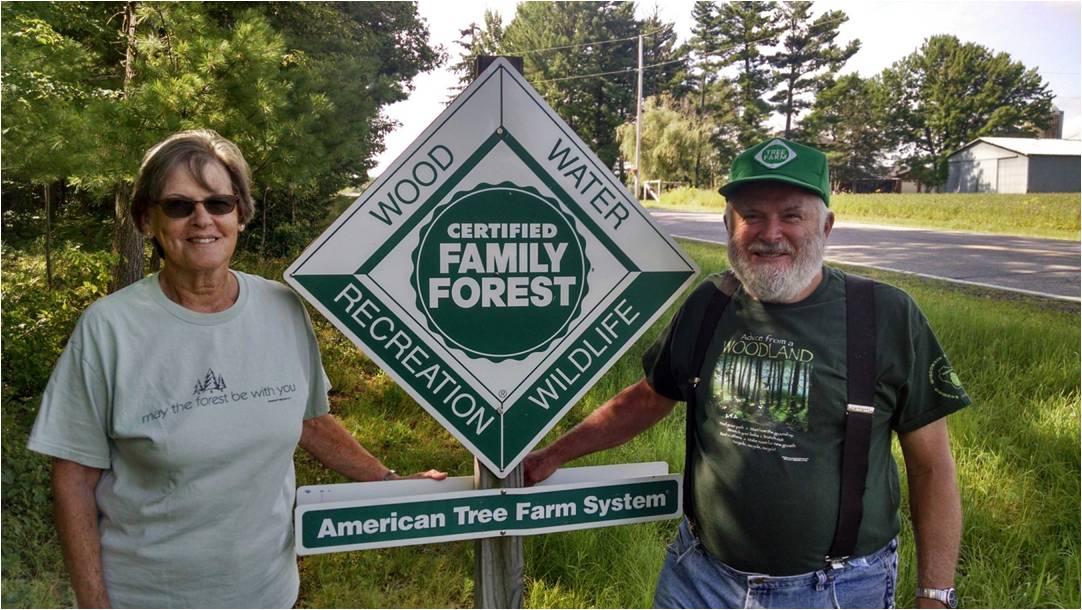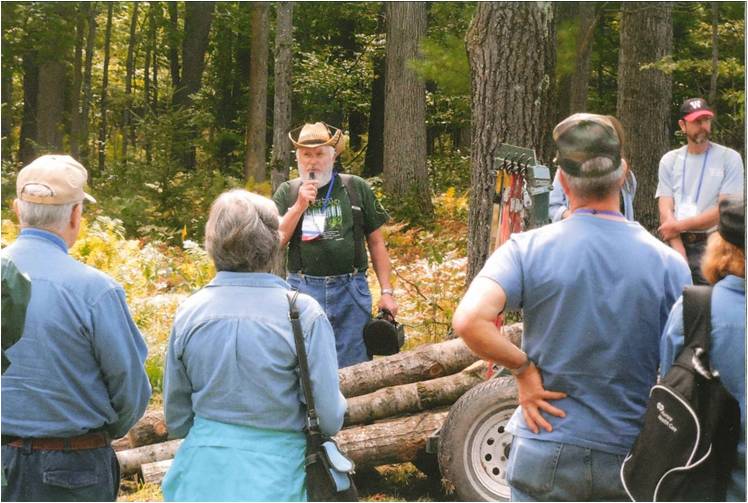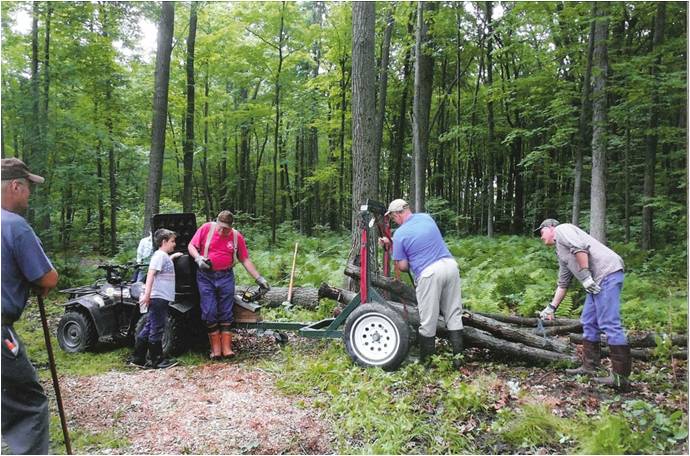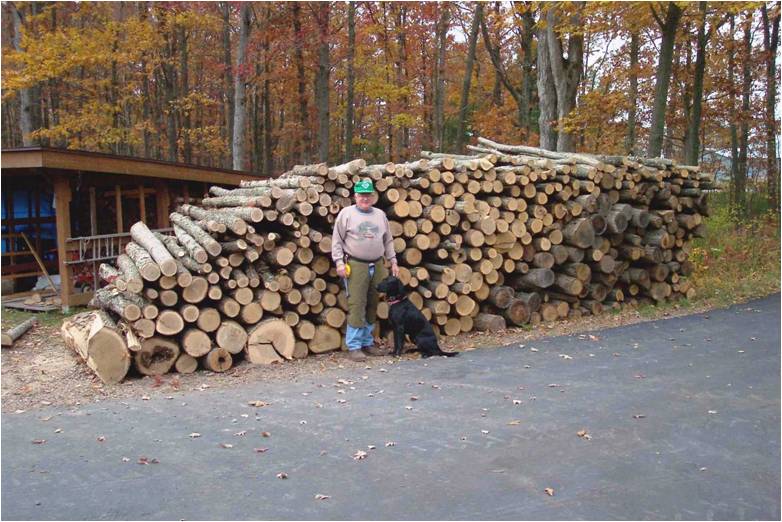North Central Nominee: Dick & Mary Czaja from Wisconsin
What makes them outstanding?
When Dick and Mary Czaja
attempted to sell their first timber sale in the early 90s to a commercial logging company, they discovered a problem faced by many small woodlot owners:
no interest from the logging community due to low timber volume and difficult
access. Instead of becoming discouraged, Dick and Mary used their ingenuity and
hard work to get the job done themselves. Using a log skidder Dick designed and
built to be pulled behind an ATV, they started down the road of being self
sufficient in implementing sustainable forest management on their 38 acre
woodlot. Over the past 25+ years, every acre on the DMC Tree Farm has been
harvested or thinned, with many acres receiving treatment more than once. They
have cut and sold over 600 cord equivalents of forest products (sawlogs,
pulpwood, and firewood) and used wood from their property for flooring and
cabinets in their home. Harvested treetops are also used in the form of chips
which are spread on trails. They have developed an extensive trail system not
only for logging but also for recreational use; they live, work, and recreate
on their property. Dick and Mary are also known statewide as ambassadors of
sustainable forestry by hosting educational events, speaking at conferences,
and being actively involved with local and state conservation organizations.
Wildlife habitat and soil and water conservation are also important
considerations. Their property has served as an example for many of how to
sustainably manage a small property for multiple uses.
logging company, they discovered a problem faced by many small woodlot owners:
no interest from the logging community due to low timber volume and difficult
access. Instead of becoming discouraged, Dick and Mary used their ingenuity and
hard work to get the job done themselves. Using a log skidder Dick designed and
built to be pulled behind an ATV, they started down the road of being self
sufficient in implementing sustainable forest management on their 38 acre
woodlot. Over the past 25+ years, every acre on the DMC Tree Farm has been
harvested or thinned, with many acres receiving treatment more than once. They
have cut and sold over 600 cord equivalents of forest products (sawlogs,
pulpwood, and firewood) and used wood from their property for flooring and
cabinets in their home. Harvested treetops are also used in the form of chips
which are spread on trails. They have developed an extensive trail system not
only for logging but also for recreational use; they live, work, and recreate
on their property. Dick and Mary are also known statewide as ambassadors of
sustainable forestry by hosting educational events, speaking at conferences,
and being actively involved with local and state conservation organizations.
Wildlife habitat and soil and water conservation are also important
considerations. Their property has served as an example for many of how to
sustainably manage a small property for multiple uses.
Tree Farmer story
Dick & Mary Czaja got their start in forest management with a woodlot they owned in eastern Wisconsin in the 1980s. They began working with the local DNR forester to properly manage their hardwood forest and completed a selective thinning using a local logging contractor. It was here that they also began their role in forest education. Dick was a member of the New London Chamber of Commerce and worked with the DNR forester to organize a field day for forest landowners at a nearby Nature Center. Their passion for sustainable forest management was born. After moving to Marshfield, Wisconsin for work they soon realized they needed to get out of the city and back into the woods. They found a nice woodlot south of Marshfield and purchased their current 40 acre property in 1992. They immediately enrolled 38 acres of the property into Wisconsin DNR's Managed Forest Law (MFL), a 25 year management commitment, retaining two acres for a future home site. Their first management plan was written that year for the MFL program. Enrolling with the ATFS that same year was a natural fit for them as well; the tree farm program helped with their "woods education" while opening the door to utilizing their property to promote sustainable forestry to others.
Their MFL management plan identified practices that were needed right away. The local DNR forester established the first timber sale in 1994, a 19 acre sale that included a coppice harvest of a seven acre aspen stand and removal of mature aspen and birch from a 12 acre oak/red maple stand. Immediately the Czajas faced several challenges in attracting a commercial logging contractor. First, access was somewhat difficult with seasonally wet soils, few established logging roads that would accommodate modern equipment, and a half mile skid from the back of the property out to the county highway. Second, the estimated harvest volume was on the low side at around 150 cords. The logging community had little interest in the sale which had seasonal logging restrictions and a fair amount of road building for a relatively small volume of wood. Undaunted, Dick and Mary took matters into their own hands and set a course that has led to decades of hard work, family enjoyment, personal satisfaction, forestry outreach, and the accompanying recognition that has followed.
Having gone through the
timber sale process previously, they knew the benefits that good forestry practices have on the land and were determined to see the same happen on their
new property. Dick had the time available and the desire to cut the trees
himself. What he needed though was a way to get the wood out to the road where
it could be sold. He designed and built his own log skidder with a winch and
cable system that could be pulled behind his ATV. Dick’s footprint on the land
is pretty small compared to what is common with commercial sized logging
operations. His trails need only be wide enough to accommodate the width of his
ATV. By using small equipment, Dick can
log most any time of year without doing damage to his trails. They began work
as a team to cut the timber sale and completed the job between 1993 and 1997,
harvesting just over 200 cords of wood.
Cut wood is brought out to a landing site near the County Highway where
it is sorted into products, sold, and picked up by a trucker.
practices have on the land and were determined to see the same happen on their
new property. Dick had the time available and the desire to cut the trees
himself. What he needed though was a way to get the wood out to the road where
it could be sold. He designed and built his own log skidder with a winch and
cable system that could be pulled behind his ATV. Dick’s footprint on the land
is pretty small compared to what is common with commercial sized logging
operations. His trails need only be wide enough to accommodate the width of his
ATV. By using small equipment, Dick can
log most any time of year without doing damage to his trails. They began work
as a team to cut the timber sale and completed the job between 1993 and 1997,
harvesting just over 200 cords of wood.
Cut wood is brought out to a landing site near the County Highway where
it is sorted into products, sold, and picked up by a trucker.
Because they manage their woodlot entirely on their own, the Czajas can respond to opportunities nature provides in a way in which a commercial operation could never do economically. Examples of the type of work they conduct include: releasing individual oak and maple crop trees, creating canopy gaps to release small patches of advanced oak regeneration, timber stand improvement cutting for firewood, shelterwood harvests in patches of mature oak followed by brush control and under-planting seedlings, small patch clearcuts to stimulate regeneration of big-tooth aspen clones, pruning of future crop trees, and protection of wildlife and other unique trees on the property. Their work in the woods involves their family members as much as possible, which has instilled a conservation ethic in three generations of the Czaja family. The family works hard together and then benefits from recreating on the property whether that’s just enjoying the land together, hiking, skiing, hunting, or viewing wildlife.
As the local DNR forester who
has had the privilege of working with Dick and Mary for 25 years, I can say
that it’s a rare landowner that can handle managing their woodlands
independently over this long of a period of time. At the time, I was skeptical
that the harvesting and thinning required under the MFL program could be
handled without having professional loggers involved in the process. My experience told me that when a landowner
tells me they want to do the cutting themselves, they usually get their fill of
being a logger after a few weekends of cutting!
Dick and Mary are definitely an exception. A note I put in their file from late 1993
states: “Dick will work on  cutting the sale himself. He has a good knowledge of forestry concepts
and harvesting.” Little did I know that 25 years later they would still be hard
at work cutting, skidding, and selling timber from the property each and every
year.
cutting the sale himself. He has a good knowledge of forestry concepts
and harvesting.” Little did I know that 25 years later they would still be hard
at work cutting, skidding, and selling timber from the property each and every
year.
In 2004, Dick and Mary were nominated and recognized as Tree Farmers of the Year for Wood County. Since that time, they have developed into statewide ambassadors for good forestry. They thoroughly enjoy spending time with people on their property, explaining what they have been doing and why. However, they know that there is always something new to learn. They recognize the value in listening to other forest landowners and learning from professional resource managers as well. More importantly, they see the big picture of the value of our private forestlands and they recognize their role in promoting those values to others.
For the following areas describe how the landowner's management addresses it
Wood: Caring for the forest resource is the backbone for all of the good management happening on the Czaja Tree Farm. Generally, forest management practices are implemented in sections on the tree farm with some harvesting occurring on an annual basis. However, because they do all of the harvesting themselves, they are able to implement management needs on a much smaller scale. A single mature tree can be identified and harvested if needed, and they can respond to forest health concerns (wind damage, insect and disease issues, etc.) in a timely manner no matter where they occur on the property. They harvest between 10 and 50 cords of wood from the property each year.
As previously mentioned, the Czajas have harvested timber on every acre of their land and are currently working on completing harvests in the hardwood stands for the second time. The first cutting in the hardwood stands involved cutting mature aspen and birch, and releasing future crop trees. The forest responded to the additional sunlight with some great natural regeneration. This second harvest is geared towards releasing and improving regeneration by harvesting mature oak and maple and influencing available sunlight to further promote development of the next forest. Tree planting has also been on-going to supplement natural regeneration and to diversify the forest.
The most recent harvest, begun in 2017, involves a second coppice harvest of big-tooth aspen mixed with scattered mature red and white oak. This three to five acre clearcut will regenerate another age class of aspen on the property and improve food and cover for wildlife.
Water: Water is an important influence on the management of the tree farm primarily due to the seasonally wet soils. There are some surface water features as well, with several small creeks and drainages through the property. Wisconsin's Forestry BMPs for Water Quality are implemented to protect water resources. This is most evident in their trail management program. Because of the soil conditions, the trails have been designed for use by lightweight vehicles, namely an ATV. Trail surfaces are crowned and strengthened with wood chips to protect the trail, limit rutting, and prevent channeling water into wetlands or streams. Hand dug ditches, open wooden culverts, and plastic PVC pipe culverts have been installed to move water away from the trail and for drainage and creek crossings.
Because the Czajas use small equipment for logging, their impact on water resources when managing their timber is small as well. Harvested trees can be winched from wetland areas or steam-side forests to the ATV which stays on the trail. This minimizes any rutting and soil disturbance that could negatively impact the quality of surface waters entering a creek or wetland.
In the spring of the year, you'll find abundant ephemeral ponds holding water for a period of time before the growing season begins. This is a time of year when the Czajas take a break from management to enjoy their land. The ephemeral ponds provide a place to view songbirds, amphibians, and small mammals using these areas for feeding, resting, and breeding.
Wildlife including threatened and endangered species: Like most landowners, the Czajas are wildlife
enthusiasts. Their woodlot is full of the two tree species most prized by
wildlife biologists: aspen and oak. These two forest types are critical for
many wildlife species popular with landowners, which include white-tailed deer,
wild turkey, ruffed grouse, and woodcock. Most importantly, the Czajas realize
that forests are a dynamic ecosystem and maintaining a healthy forest through
good management will also sustain healthy wildlife populations. They have begun
to regenerate oak to ensure this important wildlife tree is here to provide a
food source for many years to come. The aspen forests have been managed to
create several age classes for the benefit of those species dependent on young
forests.
wildlife
enthusiasts. Their woodlot is full of the two tree species most prized by
wildlife biologists: aspen and oak. These two forest types are critical for
many wildlife species popular with landowners, which include white-tailed deer,
wild turkey, ruffed grouse, and woodcock. Most importantly, the Czajas realize
that forests are a dynamic ecosystem and maintaining a healthy forest through
good management will also sustain healthy wildlife populations. They have begun
to regenerate oak to ensure this important wildlife tree is here to provide a
food source for many years to come. The aspen forests have been managed to
create several age classes for the benefit of those species dependent on young
forests.
Other wildlife practices include: construction of brush piles as habitat for rabbits and other wildlife, shrub and tree planting to diversify food sources for animals, protection of ephemeral ponds and stream-side forests as habitat for birds and other animals, and identifying and protecting selected mast and den trees for wildlife use.
According to Wisconsin DNR databases, no threatened or endangered species are known to exist on the property or in the two mile buffer of the property. However; deer, turkey, bear, grouse, squirrels, songbirds and many other animals are plentiful on the Czaja Tree Farm - just have a look at their bird feeders out the back window on any given day!
Recreation and Aesthetics including special sites: The Czaja approach to forest management has created many patches of different ages of timber which enhances aesthetics. Everything from large, old trees to young seedlings and saplings are all represented in a diversity of tree species - red oak, white oak, swamp white oak, red maple, sugar maple, big toothed aspen, trembling aspen, green ash, basswood, bitternut hickory, American elm, and black ash are all here on the tree farm.
The trail system is extensive and provides opportunities for hiking, skiing, and access for hunting or for viewing wildlife. The property lies along a county highway and one of the best sights for all to see on the property is the green and white Tree Farm sign proudly displayed on County Hwy. B.. More importantly though, the Czaja Tree Farm is the place where three generations of the family come to spend time together for holidays or special family events, to recreate on the property, and to work on the latest management project.


